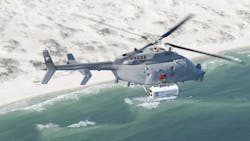Arete to integrate multispectral mine hunting sensor payloads to Navy's MQ-8C unmanned helicopters
PANAMA CITY, Fla. – Electro-optics experts at Arete Associates in Northridge, Calif., will integrate multispectral unmanned aircraft sensor payloads to help U.S. Navy unmanned helicopters detect and pinpoint enemy mines and obstacles in beach surf zones to help keep Marines safe during amphibious landings.
Officials of the Naval Surface Warfare Center Panama City Division in Panama City, Fla., announced an $13.1 million order on Friday for Arete to integrate the AN/DVS-1 Coastal Battlefield Reconnaissance and Analysis (COBRA) Block I-3A system onto the Navy MQ-8C unmanned aerial vehicle (UAV).
Carried on the Navy Northrop Grumman MQ-8 Fire Scout unmanned helicopter, the COBRA Block I system has limited detection capability in the surf zone, and enables operators and personnel to remain at safe distances for mine hunting. COBRA will be deployed from the littoral combat ship and is an integral part of the ship's mine countermeasures mission package.
COBRA uses multispectral sensors to conduct unmanned aerial tactical reconnaissance to detect and localize mine fields and obstacles in the surf zone and beach zone prior to amphibious assault.
Related: BAE Systems to develop airborne mine-hunting LIDAR for manned and unmanned aircraft
A multispectral image contains data within specific wavelength ranges to extract information the human eye fails to capture with its receptors for red, green, and blue. It measures light in 3 to 15 spectral bands to help detect otherwise-invisible mines.
The AN/DVS-1 COBRA passive multispectral sensor system is for unmanned helicopters to perform daytime surface-laid mine line and obstacle detection in the beach zone, and has off-board processing, Arete experts say.
The COBRA payload includes stabilized step stare digital gimbal, high-resolution multispectral imaging digital camera with spinning six-color filter wheel, a processing unit, and a solid-state data storage unit.
The gimbal is about 19 inches long and 11 inches in diameter, and collects six different color-band images across a large area using a step-stare pattern. At the mission, personnel load its data storage unit into a post mission analysis station.
The COBRA Block I system has two airborne payloads, the post mission analysis station, and the tactical control system segment for the UAV ground control station to plan the flight tracks for the COBRA mission, monitor the mission, and reprogram the flight path if necessary.
The Block I system primarily is aboard the Navy MQ-8B unmanned helicopter, and is being fitted to the larger MQ-8C unmanned helicopter. COBRA Block II is to enhance the COBRA system sensor to provide daytime and nighttime detection and location of unburied mine lines, mine fields, and obstacles on the beach and in surf zones. In the future, the COBRA Block III will add the capability to detect buried mines in the beach and surf zones.
Related: Sensor payloads for unmanned vehicles
The original MQ-8A and MQ-8B versions of the Navy Northrop Grumman Fire Scout UAV are based on the Schweizer 333 helicopter from Schweizer Aircraft Corp., now owned by Rotorcraft Services Group in Fort Worth, Texas. The larger MQ-8C is an unmanned version of the Bell 407 helicopter from Bell Helicopter Textron Inc. in Fort Worth, Texas.
COBRA began as a U.S. Marine Corps advanced technology program in the 1990s. The system uses incremental development, with three initial blocks of development planned with each introducing new or enhanced capabilities. COBRA Blocks II and III are in concept refinement and technology development.
On this order Arete Associates will do the work in Tucson, Ariz.; and Valpraaiso, Fla., and should be finished by February 2025. For more information contact Arete Associates online at https://arete.com, or the Naval Surface Warfare Center Panama City Division at www.navsea.navy.mil/Home/Warfare-Centers/NSWC-Panama-City.
About the Author
John Keller
Editor-in-Chief
John Keller is the Editor-in-Chief, Military & Aerospace Electronics Magazine--provides extensive coverage and analysis of enabling electronics and optoelectronic technologies in military, space and commercial aviation applications. John has been a member of the Military & Aerospace Electronics staff since 1989 and chief editor since 1995.
